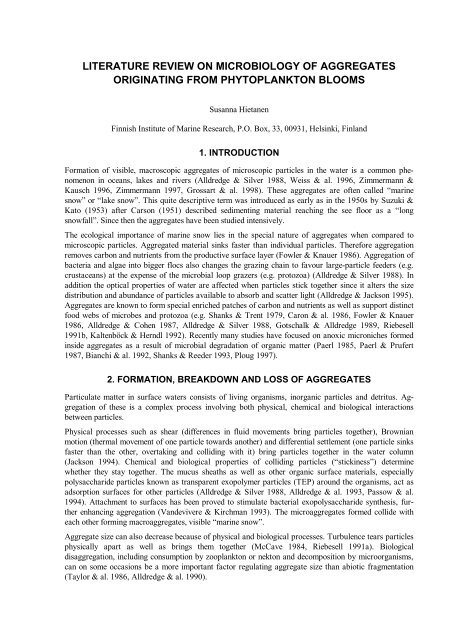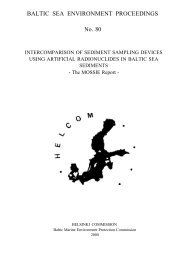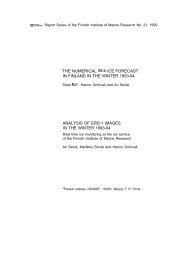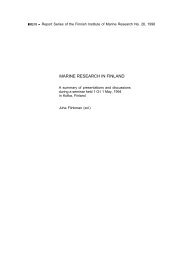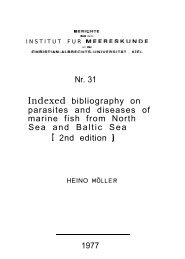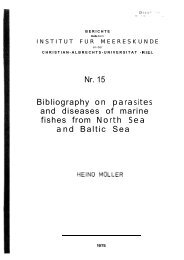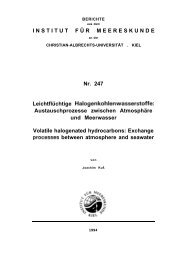Literature review on microbiology of aggregates or... - Baltic Marine ...
Literature review on microbiology of aggregates or... - Baltic Marine ...
Literature review on microbiology of aggregates or... - Baltic Marine ...
Create successful ePaper yourself
Turn your PDF publications into a flip-book with our unique Google optimized e-Paper software.
LITERATURE REVIEW ON MICROBIOLOGY OF AGGREGATESORIGINATING FROM PHYTOPLANKTON BLOOMSSusanna HietanenFinnish Institute <strong>of</strong> <strong>Marine</strong> Research, P.O. Box, 33, 00931, Helsinki, Finland1. INTRODUCTIONF<strong>or</strong>mati<strong>on</strong> <strong>of</strong> visible, macroscopic <strong>aggregates</strong> <strong>of</strong> microscopic particles in the water is a comm<strong>on</strong> phenomen<strong>on</strong>in oceans, lakes and rivers (Alldredge & Silver 1988, Weiss & al. 1996, Zimmermann &Kausch 1996, Zimmermann 1997, Grossart & al. 1998). These <strong>aggregates</strong> are <strong>of</strong>ten called “marinesnow” <strong>or</strong> “lake snow”. This quite descriptive term was introduced as early as in the 1950s by Suzuki &Kato (1953) after Cars<strong>on</strong> (1951) described sedimenting material reaching the see flo<strong>or</strong> as a “l<strong>on</strong>gsnowfall”. Since then the <strong>aggregates</strong> have been studied intensively.The ecological imp<strong>or</strong>tance <strong>of</strong> marine snow lies in the special nature <strong>of</strong> <strong>aggregates</strong> when compared tomicroscopic particles. Aggregated material sinks faster than individual particles. Theref<strong>or</strong>e aggregati<strong>on</strong>removes carb<strong>on</strong> and nutrients from the productive surface layer (Fowler & Knauer 1986). Aggregati<strong>on</strong> <strong>of</strong>bacteria and algae into bigger flocs also changes the grazing chain to favour large-particle feeders (e.g.crustaceans) at the expense <strong>of</strong> the microbial loop grazers (e.g. protozoa) (Alldredge & Silver 1988). Inadditi<strong>on</strong> the optical properties <strong>of</strong> water are affected when particles stick together since it alters the sizedistributi<strong>on</strong> and abundance <strong>of</strong> particles available to abs<strong>or</strong>b and scatter light (Alldredge & Jacks<strong>on</strong> 1995).Aggregates are known to f<strong>or</strong>m special enriched patches <strong>of</strong> carb<strong>on</strong> and nutrients as well as supp<strong>or</strong>t distinctfood webs <strong>of</strong> microbes and protozoa (e.g. Shanks & Trent 1979, Car<strong>on</strong> & al. 1986, Fowler & Knauer1986, Alldredge & Cohen 1987, Alldredge & Silver 1988, Gotschalk & Alldredge 1989, Riebesell1991b, Kaltenböck & Herndl 1992). Recently many studies have focused <strong>on</strong> anoxic micr<strong>on</strong>iches f<strong>or</strong>medinside <strong>aggregates</strong> as a result <strong>of</strong> microbial degradati<strong>on</strong> <strong>of</strong> <strong>or</strong>ganic matter (Paerl 1985, Paerl & Prufert1987, Bianchi & al. 1992, Shanks & Reeder 1993, Ploug 1997).2. FORMATION, BREAKDOWN AND LOSS OF AGGREGATESParticulate matter in surface waters c<strong>on</strong>sists <strong>of</strong> living <strong>or</strong>ganisms, in<strong>or</strong>ganic particles and detritus. Aggregati<strong>on</strong><strong>of</strong> these is a complex process involving both physical, chemical and biological interacti<strong>on</strong>sbetween particles.Physical processes such as shear (differences in fluid movements bring particles together), Brownianmoti<strong>on</strong> (thermal movement <strong>of</strong> <strong>on</strong>e particle towards another) and differential settlement (<strong>on</strong>e particle sinksfaster than the other, overtaking and colliding with it) bring particles together in the water column(Jacks<strong>on</strong> 1994). Chemical and biological properties <strong>of</strong> colliding particles (“stickiness”) determinewhether they stay together. The mucus sheaths as well as other <strong>or</strong>ganic surface materials, especiallypolysaccharide particles known as transparent exopolymer particles (TEP) around the <strong>or</strong>ganisms, act asads<strong>or</strong>pti<strong>on</strong> surfaces f<strong>or</strong> other particles (Alldredge & Silver 1988, Alldredge & al. 1993, Passow & al.1994). Attachment to surfaces has been proved to stimulate bacterial exopolysaccharide synthesis, furtherenhancing aggregati<strong>on</strong> (Vandevivere & Kirchman 1993). The micro<strong>aggregates</strong> f<strong>or</strong>med collide witheach other f<strong>or</strong>ming macro<strong>aggregates</strong>, visible “marine snow”.Aggregate size can also decrease because <strong>of</strong> physical and biological processes. Turbulence tears particlesphysically apart as well as brings them together (McCave 1984, Riebesell 1991a). Biologicaldisaggregati<strong>on</strong>, including c<strong>on</strong>sumpti<strong>on</strong> by zooplankt<strong>on</strong> <strong>or</strong> nekt<strong>on</strong> and decompositi<strong>on</strong> by micro<strong>or</strong>ganisms,can <strong>on</strong> some occasi<strong>on</strong>s be a m<strong>or</strong>e imp<strong>or</strong>tant fact<strong>or</strong> regulating aggregate size than abiotic fragmentati<strong>on</strong>(Tayl<strong>or</strong> & al. 1986, Alldredge & al. 1990).
38Hietanen Meri No. 37:37-44, 1998Aggregates are lost from the upper water layer by sedimentati<strong>on</strong>, which is enhanced by growing <strong>aggregates</strong>ize, and by grazing (Alldredge & Silver 1988). Grazing <strong>of</strong> <strong>aggregates</strong> by fish and zooplankt<strong>on</strong> hasrecently been proved to be an imp<strong>or</strong>tant sh<strong>or</strong>tcut in the food chain, transferring <strong>or</strong>ganic carb<strong>on</strong> to highertrophic levels m<strong>or</strong>e efficiently than via the microbial loop (Lampitt & al. 1993, Grossart & al. 1998).The relative imp<strong>or</strong>tance <strong>of</strong> these mechanisms in aggregate disappearance depends <strong>on</strong> the <strong>or</strong>igin and age <strong>of</strong>the <strong>aggregates</strong> (Biddanda & Pomeroy 1988, Riebesell 1991a, Turley 1992).2.1 Aggregati<strong>on</strong> and fate <strong>of</strong> diatom bloomA two-state coagulati<strong>on</strong> the<strong>or</strong>y, in which coagulati<strong>on</strong> is insignificant at low and significant at high algalc<strong>on</strong>centrati<strong>on</strong>s with a rapid transiti<strong>on</strong> between these two states, seems to adequately describe the dynamics<strong>of</strong> diatom blooms (Jacks<strong>on</strong> 1990, Riebesell 1991a, Kiørboe & al. 1994). At the beginning <strong>of</strong> thebloom there is no coagulati<strong>on</strong> <strong>of</strong> cells into <strong>aggregates</strong> neither is there any sinking <strong>of</strong> cells out <strong>of</strong> theeuphotic z<strong>on</strong>e. The c<strong>on</strong>centrati<strong>on</strong> <strong>of</strong> diatom cells increases rapidly until a critical limit is reached. Thecritical cell c<strong>on</strong>centrati<strong>on</strong> depends <strong>on</strong> cell sizes, cell surface “stickiness” and turbulence <strong>of</strong> water. At thecritical c<strong>on</strong>centrati<strong>on</strong> the cells aggregate, sometimes extremely quickly - the whole bloom aggregated andsedimented in 24 hours in the study <strong>of</strong> Alldredge & Gotschalk (1989). This pattern f<strong>or</strong> diatom bloomdynamics has also been rep<strong>or</strong>ted from the <strong>Baltic</strong> Sea spring bloom - an initial intensive bloom followedby rapid sedimentati<strong>on</strong> as a result <strong>of</strong> nutrient depleti<strong>on</strong> (Leppänen 1988, Leppänen & K<strong>on</strong><strong>on</strong>en 1988,Kuparinen & al. 1996, Kankaanpää & al. 1997). Nutrient depleti<strong>on</strong> at the end <strong>of</strong> a bloom has beenshown to increase diatom cell stickiness, enhancing aggregati<strong>on</strong> (Smetacek 1985, Logan & Alldredge1989, Kiørboe & al. 1994). Even if the algal cells keep dividing, the particle c<strong>on</strong>centrati<strong>on</strong> does notincrease further since new producti<strong>on</strong> <strong>aggregates</strong> quickly (Jacks<strong>on</strong> 1990, Riebesell 1991b). Aggregatesare col<strong>on</strong>ised by bacteria and protozoa (Alldredge & Gotschalk 1990, Sim<strong>on</strong> & al. 1990, Zimmermann &Kausch 1996), but because <strong>of</strong> the relatively high density <strong>of</strong> diatom <strong>aggregates</strong> they sink rapidly from theproductive layer bef<strong>or</strong>e maj<strong>or</strong> decompositi<strong>on</strong> takes place (Smetacek 1985, Alldredge & Gotschalk 1989,Riebesell 1991b).2.2 Aggregati<strong>on</strong> and fate <strong>of</strong> cyanobacteria bloomCyanobacterial blooms also aggregate, especially as they age (Hoppe 1981), but the fate <strong>of</strong> cyanobacterial<strong>aggregates</strong> differs from that <strong>of</strong> diatom <strong>aggregates</strong>. Intracellular gas vacuoles prevent sedimentati<strong>on</strong>,keeping aggregated filaments in the upper water layer (Hoppe 1981, W<strong>or</strong>m & Søndergaard 1998).Grazing losses are also insignificant since grazers avoid cyanobacteria because <strong>of</strong> their “difficult” sizeand shape (filaments, col<strong>on</strong>ies and especially <strong>aggregates</strong>) and potential toxicity (e.g. Estep & Vigg 1985,Haney 1987). As a result, cyanobacterial <strong>aggregates</strong> are so<strong>on</strong> col<strong>on</strong>ised by bacteria and protozoa,becoming sites <strong>of</strong> enhanced biological, especially microbial, activity (Paerl 1976, Caldwell & Caldwell1978, Silver & al. 1978, Hoppe 1981, Car<strong>on</strong> & al. 1982, Zimmermann & Kausch 1996, Grossart & al.1998). These c<strong>on</strong>diti<strong>on</strong>s can predominate f<strong>or</strong> weeks, even m<strong>on</strong>ths (Hoppe 1981), until increased turbulencedis<strong>aggregates</strong> the whole bloom (Heiskanen & K<strong>on</strong><strong>on</strong>en 1994).3. ABUNDANCE OF AGGREGATESAbundance <strong>of</strong> <strong>aggregates</strong> cannot be estimated by traditi<strong>on</strong>al water sampling methods because <strong>of</strong> theextreme fragility <strong>of</strong> the flocs. Theref<strong>or</strong>e a variety <strong>of</strong> advanced methods, each <strong>of</strong> which has some drawbacks,have been developed to study aggregate quantities.Traditi<strong>on</strong>al sediment traps seem to either destroy <strong>aggregates</strong> if preservatives (e.g. f<strong>or</strong>malin) are used <strong>or</strong>,in the absence <strong>of</strong> such agents, lose some matter by biodegradati<strong>on</strong>. Large volume in situ filtrati<strong>on</strong> systems(LVFS) provide data <strong>on</strong> particle numbers and size distributi<strong>on</strong> in the water column, also allowingparticle density calculati<strong>on</strong>s. It still remains unclear, however, what these deep-sea pumps actuallysample ("suspended particles" v. "large, fast sinking particles"). Most studies rely <strong>on</strong> lab<strong>or</strong>ous handcollecti<strong>on</strong> in situ by SCUBA diving, some take advantage <strong>of</strong> submersibles. Recent advances in in situ
<str<strong>on</strong>g>Literature</str<strong>on</strong>g> <str<strong>on</strong>g>review</str<strong>on</strong>g> <strong>on</strong> <strong>microbiology</strong> <strong>of</strong> <strong>aggregates</strong> <strong>or</strong>iginating from phytoplankt<strong>on</strong> blooms 39photography and video techniques have made these methods useful in aggregate as well as other marinestudies (<str<strong>on</strong>g>review</str<strong>on</strong>g>ed by Fowler & Knauer 1986).Table 1. Abundance <strong>of</strong> <strong>aggregates</strong> at some locati<strong>on</strong>s.Locati<strong>on</strong> Abundance, l -1 Method ReferenceSubtropical Atlantic,Bahama Islands 0.0005-0.004 Submersible Alldredge & Youngbluth 1985Gulf Stream 0.1 SCUBA / hand collecti<strong>on</strong> Alldredge & al. 1986Calif<strong>or</strong>nian coast 4.3 SCUBA / hand collecti<strong>on</strong> Alldredge & al. 1986Calif<strong>or</strong>nian coast 0.5-12.9 SCUBA / hand collecti<strong>on</strong> Alldredge & Gotschalk 1989Calif<strong>or</strong>nian coast 0.2-1.65 SCUBA / hand collecti<strong>on</strong> Alldredge & Gotschalk 1990Calif<strong>or</strong>nian coast 0.2-1.65 SCUBA / number <strong>of</strong> aggr. passingthrough a hand-held loop in a givendistanceSim<strong>on</strong> & al. 1990German Bight 425-5300 Underwater camera Riebesell 1991aAntarctic coast 0.1-10 Remote-c<strong>on</strong>trolled video camera Marchant & al. 1996Lake C<strong>on</strong>stance,Germany 5-20 SCUBA / hand collecti<strong>on</strong> Weiss & al. 1996Elbe Estuary 40-120 wide-mouth bottles Zimmermann & Kausch 19964. MICROBIAL COLONISATION AND SUCCESSION IN AGGREGATESYoung and healthy phytoplankt<strong>on</strong> cells seldom show any bacterial col<strong>on</strong>isati<strong>on</strong> (Paerl 1976, Hoppe1981). As the cells age, however, they start aggregating and quickly become attached by micro-<strong>or</strong>ganisms.The predominant sites f<strong>or</strong> bacterial col<strong>on</strong>isati<strong>on</strong> are the inactive cells al<strong>on</strong>g the filaments, preferablysurrounded by mucilage (Caldwell & Caldwell 1978, Hoppe 1981, Grossart & al. 1998), andpolar regi<strong>on</strong>s <strong>of</strong> heterocysts in cyanobacterial col<strong>on</strong>ies, capable <strong>of</strong> nitrogen fixati<strong>on</strong> (Paerl 1976). Thebacterial populati<strong>on</strong> serves as a food source f<strong>or</strong> e.g. protozoa, supp<strong>or</strong>ting a complex microecosystem(Silver & al. 1978, Hoppe 1981, Biddanda 1985, Tayl<strong>or</strong> & al. 1986, Alldredge & Silver 1988, Alldredge& Gotschalk 1990, Zimmermann & Kausch 1996). Heterotrophic producti<strong>on</strong> blooms as l<strong>on</strong>g as primaryproducti<strong>on</strong> by phytoplankt<strong>on</strong> cells supplies the heterotrophic community with the <strong>or</strong>ganic substrate itneeds. In aging <strong>aggregates</strong>, senescent algae al<strong>on</strong>e al<strong>on</strong>e provide a sufficient amount <strong>of</strong> degradablematerial f<strong>or</strong> the maintenance <strong>of</strong> a high standing stock <strong>of</strong> attached bacteria. Theref<strong>or</strong>e the role <strong>of</strong> the“recycling” <strong>of</strong> <strong>or</strong>ganic matter from microzooplankt<strong>on</strong> (as excreti<strong>on</strong>, dead cells, fecal pellets, sloppyfeeding) towards bacteria is emphasised as the <strong>aggregates</strong> get older (Hoppe 1981, Tayl<strong>or</strong> & al. 1986,Biddanda & Pomeroy 1988). Cyanobacterial <strong>aggregates</strong> that avoid sedimentati<strong>on</strong> and theref<strong>or</strong>e stay inthe upper water layer f<strong>or</strong> weeks can reach a steady state in which the input and output <strong>of</strong> <strong>or</strong>ganic matteris balanced (Hoppe 1981). Müller-Niklas & al. (1994) showed that aging processes are, however, similarin buoyant and sinking particles. With increasing size and age, <strong>aggregates</strong> become po<strong>or</strong> habitats f<strong>or</strong>bacterial growth. Rapid successi<strong>on</strong>al changes in microbial populati<strong>on</strong>s suggest that any labile matteravailable in newly f<strong>or</strong>med <strong>aggregates</strong> is quickly utilised by bacteria (Alldredge & Silver 1988, Alldredge& Gotschalk 1990).5. PROCESSES IN AGGREGATES5.1 Primary producti<strong>on</strong>The amount <strong>of</strong> primary producti<strong>on</strong> in <strong>aggregates</strong> depends e.g. <strong>on</strong> the size <strong>of</strong> the aggregate (shading in big<strong>aggregates</strong>, enhanced sinking), physical state <strong>of</strong> the algae in aggregate (healthy v. senescent cells),
40Hietanen Meri No. 37:37-44, 1998availability <strong>of</strong> nutrients (nutrient recycling by attached bacteria, nitrogen fixati<strong>on</strong>) and turbulence(keeping the cells in the productive water layer <strong>or</strong> allowing them sink). Theref<strong>or</strong>e aggregati<strong>on</strong> can eitherenhance <strong>or</strong> diminish the primary producti<strong>on</strong> <strong>of</strong> phytoplankt<strong>on</strong> cells. As a general rule, the c<strong>on</strong>tributi<strong>on</strong> <strong>of</strong>primary producti<strong>on</strong> in <strong>aggregates</strong> to the total primary producti<strong>on</strong> in the euphotic layer is significant <strong>on</strong>lyin newly f<strong>or</strong>med, phytoplankt<strong>on</strong>-<strong>or</strong>iginated <strong>aggregates</strong> (Alldredge & Gotschalk 1990).5.2 Heterotrophic producti<strong>on</strong>Abundance and heterotrophic producti<strong>on</strong> <strong>of</strong> attached bacteria has already been studied intensively f<strong>or</strong> acouple <strong>of</strong> decades, but the results are still somewhat c<strong>on</strong>tradict<strong>or</strong>y. Depending <strong>on</strong> the method used, locati<strong>on</strong>and time <strong>of</strong> year, the abundance and producti<strong>on</strong> <strong>of</strong> bacteria in <strong>aggregates</strong> has been claimed to beeither significant <strong>or</strong> negligible compared to that <strong>of</strong> free-living bacteria (Table 2). This might also reflectdiscrepancies in the timing <strong>of</strong> sampling since microbial activity <strong>on</strong> marine snow is highly variable anddepends <strong>on</strong> aggregate <strong>or</strong>igin as well as aggregate age (Alldredge & Silver 1988, Herndl 1988, Alldredge& Gotschalk 1990).Table 2. The abundance and producti<strong>on</strong> <strong>of</strong> attached bacteria compared to that <strong>of</strong> total pelagic bacteriaat some locati<strong>on</strong>s.Locati<strong>on</strong>Attached bacteria,% <strong>of</strong> allMethodProd. <strong>of</strong> attached bacteria,% <strong>of</strong> total Reference-1ng C l -1 hBilbao Coast, Spain 1-22 Iriberri & al. 1987Elbe Estuary 75 Zimmermann 1997Freshwater p<strong>on</strong>d
<str<strong>on</strong>g>Literature</str<strong>on</strong>g> <str<strong>on</strong>g>review</str<strong>on</strong>g> <strong>on</strong> <strong>microbiology</strong> <strong>of</strong> <strong>aggregates</strong> <strong>or</strong>iginating from phytoplankt<strong>on</strong> blooms 411996). This finding might explain some differences observed between free-living and attached bacteriasince all bacterial groups found <strong>on</strong> <strong>aggregates</strong> in these studies are known to have special properties thatmake them well-adjusted to attached life (DeL<strong>on</strong>g & al. 1993, Weiss & al. 1996). These special featuresinclude a tendency to associate and glide <strong>on</strong> surfaces as well as an ability to produce differentexoenzymes and to degrade a variety <strong>of</strong> high molecular weight compounds (DeL<strong>on</strong>g & al. 1993).5.3 Nitrogen processesAggregates are known to be sites <strong>of</strong> intense nutrient cycling (e.g. Shanks & Trent 1979, Car<strong>on</strong> & al.1986, Fowler & Knauer 1986, Alldredge & Cohen 1987, Alldredge & Silver 1988, Gotschalk &Alldredge 1989, Alldredge & Gotschalk 1990, Riebesell 1991b, Kaltenböck & Herndl 1992). This <str<strong>on</strong>g>review</str<strong>on</strong>g><strong>on</strong>ly discusses nitrogen processes in cyanobacterial <strong>aggregates</strong>.The biological nitrogen cycle c<strong>on</strong>sists <strong>of</strong> reacti<strong>on</strong>s that are mainly carried out by bacteria. Plants canassimilate amm<strong>on</strong>ia and nitrate, but nitrogen fixati<strong>on</strong>, amm<strong>on</strong>ificati<strong>on</strong>, nitrificati<strong>on</strong> and denitrificati<strong>on</strong> arestrictly microbial processes (Stanier & al. 1971). Likewise, anaerobic amm<strong>on</strong>ium oxidati<strong>on</strong> to dinitrogengas has been shown to be a microbially mediated process (van de Graaf & al. 1995).Cyanobacteria capable <strong>of</strong> fixing dissolved molecular nitrogen (N 2) regularly aggregate during intensiveblooms. Since the sedimentati<strong>on</strong> and grazing <strong>of</strong> these <strong>aggregates</strong> is min<strong>or</strong> (Hoppe 1981, Heiskanen &K<strong>on</strong><strong>on</strong>en 1994), they have been c<strong>on</strong>sidered a net nitrogen input in the ecosystem. Nevertheless, the fate <strong>of</strong>nitrogen fixed by cyanobacteria still remains uncertain. The alternatives in the<strong>or</strong>y are that fixed nitrogenis released into the surrounding water as the cyanobacterial cells lyse at the end <strong>of</strong> the bloom (Heiskanen& K<strong>on</strong><strong>on</strong>en 1994), <strong>or</strong> that nitrogen is at least partly c<strong>on</strong>verted back into gaseous dinitrogen by anaerobicdenitrificati<strong>on</strong> processes.Both nitrogen fixati<strong>on</strong> and denitrificati<strong>on</strong> are oxygen-sensitive processes. Denitrifying bacteria arefacultative anaerobes that denitrify in anaerobic envir<strong>on</strong>ments, although some bacteria may simultaneouslynitrify and denitrify in aerobic envir<strong>on</strong>ments (Roberts<strong>on</strong> & Kuenen 1984). Theref<strong>or</strong>e, the f<strong>or</strong>mati<strong>on</strong><strong>of</strong> microscale anoxic patches in <strong>aggregates</strong> plays a key role in both nitrogen fixati<strong>on</strong> and denitrificati<strong>on</strong>rates in <strong>aggregates</strong>. Anoxic microz<strong>on</strong>es and denitrificati<strong>on</strong> have been dem<strong>on</strong>strated in activated sludgeflocs at waste water treatment plants (de Beer & al. 1997). Recently, Michotey & B<strong>on</strong>in (1997)dem<strong>on</strong>strated particle-associated denitrificati<strong>on</strong> in the Mediterranean Sea. Nitrogen fixati<strong>on</strong> has beenshown to be m<strong>or</strong>e active in cyanobacterial <strong>aggregates</strong> than in suspended filaments (Paerl 1985, Paerl &Prufert 1987). The existence <strong>of</strong> micr<strong>on</strong>iches in cyanobacterial <strong>aggregates</strong> has also been proved experimentallyin many studies (Paerl 1985, Alldredge & Cohen 1987, Paerl & Prufert 1987, Bianchi & al.1992, Shanks & Reeder 1993, Ploug & al. 1997), but the fact<strong>or</strong>s regulating their quantity are not totallyunderstood. Aggregates, like sediments, provide both a col<strong>on</strong>isable surface and a c<strong>on</strong>centrated source <strong>of</strong>readily metabolisable <strong>or</strong>ganic matter. Microbial degradati<strong>on</strong> <strong>of</strong> <strong>or</strong>ganic matter results in oxygen-po<strong>or</strong>microz<strong>on</strong>es around and inside particles (Paerl & Prufert 1987). Anoxic patches remain even in welloxygenatedsurroundings as the physical structure provided by the aggregate slows down the diffusi<strong>on</strong> inand out <strong>of</strong> the microz<strong>on</strong>e (Shanks & Reeder 1993). Paerl (1985) and Ploug & al. (1997) point to theimp<strong>or</strong>tance <strong>of</strong> low envir<strong>on</strong>mental turbulence and de Beer & al. (1997) to the complicated structure <strong>of</strong><strong>aggregates</strong> in microz<strong>on</strong>e f<strong>or</strong>mati<strong>on</strong>. These requirements are easily met in cyanobacterial <strong>aggregates</strong> thatf<strong>or</strong>m under almost n<strong>on</strong>-existent turbulence and seem to actively fix both carb<strong>on</strong> and nitrogen.6. SUMMARYPhytoplankt<strong>on</strong>-derived <strong>aggregates</strong> seem to be an imp<strong>or</strong>tant phenomen<strong>on</strong> in pelagic ecosystems, albeitephemeral in an annual time scale.Regular aggregati<strong>on</strong> <strong>of</strong> phytoplankt<strong>on</strong> blooms provides unique microenvir<strong>on</strong>ments with highly specializedpopulati<strong>on</strong>s and trophic interacti<strong>on</strong>s, thus increasing the biodiversity <strong>of</strong> oligotrophic pelagial waters.
42Hietanen Meri No. 37:37-44, 1998Physical aspects <strong>of</strong> aggregati<strong>on</strong>, disaggregati<strong>on</strong> and aggregate loss from the water column seem to bequite well described. Our understanding <strong>of</strong> biological processes in <strong>aggregates</strong> however remains incomplete.In <strong>or</strong>der to estimate the c<strong>on</strong>tributi<strong>on</strong> <strong>of</strong> aggregate-associated processes to those <strong>of</strong> free-living <strong>or</strong>ganisms,we need to focus <strong>on</strong> developing methods to measure the key processes in <strong>aggregates</strong>. The highmetabolical rates detected so far in <strong>aggregates</strong> indicate that their role in the water column might be fargreater than expected from their brief appearances.REFERENCESAlldredge, A.L. & Cohen, Y. 1987: Can microscale chemical patches persist in the sea? Microelectrode study<strong>of</strong> marine snow and fecal pellets. - Science 235: 689-691.Alldredge, A., Cole, J.J. & Car<strong>on</strong>, D.A. 1986: Producti<strong>on</strong> <strong>of</strong> heterotrophic bacteria inhabiting macroscopic<strong>or</strong>ganic <strong>aggregates</strong> (marine snow) from surface waters. - Limnol. Oceanogr. 31: 68-78.Alldredge, A.L. & Gotschalk, C.C. 1989: Direct observati<strong>on</strong>s <strong>of</strong> the mass flocculati<strong>on</strong> <strong>of</strong> diatom blooms:characteristics, settling velocities and f<strong>or</strong>mati<strong>on</strong> <strong>of</strong> diatom <strong>aggregates</strong>. - Deep-Sea. Res. 36: 159-171.Alldredge, A.L. & Gotschalk, C.C. 1990: The relative c<strong>on</strong>tributi<strong>on</strong> <strong>of</strong> marine snow <strong>of</strong> different <strong>or</strong>igins tobiological processes in coastal waters. - C<strong>on</strong>t. Shelf Res. 10: 41-58.Alldredge, A.L., Granata, T.C., Gotschalk, C.C. & Dickey, T.D. 1990: The physical strength <strong>of</strong> marine snowand its implicati<strong>on</strong>s f<strong>or</strong> particle disaggregati<strong>on</strong> in the ocean. - Limnol. Oceanogr. 35: 1415-1428.Alldredge, A.L. & Jacks<strong>on</strong>, G.A. 1995: Aggregati<strong>on</strong> in marine systems. - Deep-Sea Res. 42: 1-7.Alldredge, A.L., Passow, U. & Logan, B.E. 1993: The abundance and significance <strong>of</strong> a class <strong>of</strong> large, transparent<strong>or</strong>ganic particles in the ocean. - Deep-Sea Res. II. 40, 1131-1140.Alldredge, A.L. & Silver, M.W. 1988: Characteristics, dynamics and significance <strong>of</strong> marine snow. - Prog.Oceanog. 20: 41-82.Alldredge, A.L. & Youngbluth, M.J. 1985: The significance <strong>of</strong> macroscopic <strong>aggregates</strong> (marine snow) as sitesf<strong>or</strong> heterotrophic bacterial producti<strong>on</strong> in the mesopelagic z<strong>on</strong>e <strong>of</strong> the subtropical Atlantic.- Deep-Sea Res. 32: 1445-1456.de Beer, D., Schramm, A., Santegoeds, C.M. & Nielsen, H.K. 1997: Anaerobic processes in activated sludge.- Proceedings <strong>of</strong> Sec<strong>on</strong>d Internati<strong>on</strong>al C<strong>on</strong>ference <strong>on</strong> Micro<strong>or</strong>ganisms in activated sludge and bi<strong>of</strong>ilmprocesses: 783-786.Bianchi, M., Marty, D., Teyssié, J.-L. & Fowler, S.W. 1992: Strictly aerobic and anaerobic bacteria associatedwith sinking particulate matter and zooplankt<strong>on</strong> fecal pellets. - Mar. Ecol. Prog. Ser. 88: 55-60.Biddanda, B.A. 1985: Microbial synthesis <strong>of</strong> macroparticulate matter. - Mar. Ecol. Prog. Ser. 20: 241-251.Biddanda, B.A. & Pomeroy, L.R. 1988: Microbial aggregati<strong>on</strong> and degradati<strong>on</strong> <strong>of</strong> phytoplankt<strong>on</strong>-deriveddetritus in seawater. I. Microbial successi<strong>on</strong>. - Mar. Ecol. Prog. Ser. 42: 79-88.Caldwell, D.E. & Caldwell, S.J. 1978: A Zoogloea sp. associated with blooms <strong>of</strong> Anabaena flos-aquae.- Can. J. Microbiol. 24: 922-931.Car<strong>on</strong>, D.A., Davis, G.D., Madin, L.P. & Sieburth, J. McN. 1982: Heterotrophic bacteria and bacteriv<strong>or</strong>ousprotozoa in oceanic macro<strong>aggregates</strong>. - Science 218: 795-797.Car<strong>on</strong>, D.A., Davis, G.D., Madin, L.P. & Sieburth, J. McN. 1986: Enrichment <strong>of</strong> microbial populati<strong>on</strong>s inmacro<strong>aggregates</strong> (marine snow) from surface waters <strong>of</strong> the N<strong>or</strong>th Atlantic. - J. Mar. Res. 44: 543-565.Cars<strong>on</strong>, R. 1951: The Sea Around Us. - Oxf<strong>or</strong>d University Press, 230 pp.DeL<strong>on</strong>g, E.F. , Franks, D.G. & Alldredge, A.L. 1993: Phylogenetic diversity <strong>of</strong> aggregate-attached vs. freelivingmarine bacterial assemblages. - Limnol. Oceanogr. 38: 924-934.Estep, M.L.F. & Vigg, S. 1985: Stable carb<strong>on</strong> and nitrogen isotope tracers <strong>of</strong> trophic dynamics in naturalpopulati<strong>on</strong>s and fisheries <strong>of</strong> the Lah<strong>on</strong>tan Lake System, Nevada. - Can. J. Fish. Aquat. Sci. 42: 1712-1719.Fowler, S.W. & Knauer, G.A. 1986: Role <strong>of</strong> large particles in the transp<strong>or</strong>t <strong>of</strong> elements and <strong>or</strong>ganic compoundsthrough the oceanic water column. - Prog. Oceanog. 16: 147-194.Gotschalk, C.C. & Alldredge, A.L. 1989: Enhanced primary producti<strong>on</strong> and nutrient regenerati<strong>on</strong> withinaggregated marine diatoms. - Mar. Biol. 103: 119-129.Grossart, H-P., Berman, T., Sim<strong>on</strong>, M. & Pohlmann, K. 1998: Occurrence and microbial dynamics <strong>of</strong> macroscopic<strong>or</strong>ganic <strong>aggregates</strong> (lake snow) in Lake Kinneret, Israel, in fall. - Aquat. Microb. Ecol. 14: 59-67.
<str<strong>on</strong>g>Literature</str<strong>on</strong>g> <str<strong>on</strong>g>review</str<strong>on</strong>g> <strong>on</strong> <strong>microbiology</strong> <strong>of</strong> <strong>aggregates</strong> <strong>or</strong>iginating from phytoplankt<strong>on</strong> blooms 43Haney, J.F. 1987: Field studies <strong>of</strong> zooplankt<strong>on</strong> - cyanobacteria interacti<strong>on</strong>s. - NZ J. Mar. Freshw. Res. 21:467-475.Harvey, R.W. & Young, Y. 1980: Enumerati<strong>on</strong> <strong>of</strong> particle-bound and unattached respiring bacteria in the saltmarsh envir<strong>on</strong>ment. - Appl. Envir<strong>on</strong>. Microbiol. 40: 156-160.Heiskanen, A.-S. & K<strong>on</strong><strong>on</strong>en, K. 1994: Sedimentati<strong>on</strong> <strong>of</strong> vernal and late summer phytoplankt<strong>on</strong> communitiesin the coastal <strong>Baltic</strong> Sea. - Arch. Hydrobiol. 131: 175-198.Herndl, G.J. 1988: Ecology <strong>of</strong> am<strong>or</strong>phous aggregati<strong>on</strong>s (marine snow) in the N<strong>or</strong>thern Adriatic Sea. II. Microbialdensity and activity in marine snow and its implicati<strong>on</strong> to overall pelagic processes. - Mar. Ecol.Prog. Ser. 48: 265-275.Hoppe, H.-G. 1981: Blue-green algae agglomerati<strong>on</strong> in surface water: a microbiotope <strong>of</strong> high bacterial activity.- Kieler Meeresf<strong>or</strong>sch., S<strong>on</strong>derh. 5: 291-303.Hoppe, H.-G., Kim, S.J. & Gocke, K. 1988: Microbial decompositi<strong>on</strong> in aquatic envir<strong>on</strong>ments: combinedprocess <strong>of</strong> extracellular enzyme activity and substrate uptake. - Appl. Envir<strong>on</strong>. Microbiol. 54: 784-790.Iriberri, J., Unanue, M., Barcina, I. & Egea, L. 1987: Seas<strong>on</strong>al variati<strong>on</strong> in populati<strong>on</strong> density and heterotrophicactivity <strong>of</strong> attached and free-living bacteria in coastal waters. - Appl. Envir<strong>on</strong>. Microbiol.53: 2308-2314.Jacks<strong>on</strong>, G. 1990: A model f<strong>or</strong> the f<strong>or</strong>mati<strong>on</strong> <strong>of</strong> marine algal flocs by physical coagulati<strong>on</strong> processes.- Deep-Sea Res. 37: 1197-1211.Jacks<strong>on</strong>, G. 1994: Particle traject<strong>or</strong>ies in a rotating cylinder: implicati<strong>on</strong>s f<strong>or</strong> aggregati<strong>on</strong> incubati<strong>on</strong>s.- Deep-Sea Res. 41: 429-437.Kaltenböck, E. & Herndl, G.J. 1992: Ecology <strong>of</strong> am<strong>or</strong>phous aggregati<strong>on</strong>s (marine snow) in the N<strong>or</strong>thernAdriatic Sea. IV. Dissolved nutrients and the autotrophic community associated with marine snow.- Mar. Ecol. Prog. Ser. 87: 147-159.Kankaanpää, H., K<strong>or</strong>h<strong>on</strong>en, M., Heiskanen, A.-M. & Su<strong>or</strong>tti, A.-M. 1997: Seas<strong>on</strong>al sedimentati<strong>on</strong><strong>of</strong> <strong>or</strong>ganicmatter and c<strong>on</strong>taminants in the Gulf <strong>of</strong> Finland. - B<strong>or</strong>eal Env. Res. 2: 257-274.Karner, M. & Herndl, G.J. 1992: Extracellular enzymatic activity and sec<strong>on</strong>dary producti<strong>on</strong> in free-living andmarine-snow-associated bacteria. - Mar. Biol. 113: 341-347.Kirchman, D. 1983: The producti<strong>on</strong> <strong>of</strong> bacteria attached to particles suspended in a freshwater p<strong>on</strong>d. - Limnol.Oceanogr. 28: 858-872.Kirchman, D. & Mitchell, R. 1982: C<strong>on</strong>tributi<strong>on</strong> <strong>of</strong> particle-bound bacteria to total microheterotrophic activityin five p<strong>on</strong>ds and two marshes. - Appl. Envir<strong>on</strong>. Microbiol. 43: 200-209.Kiørboe, T., Lundsgaard, C., Olesen, M. & Hansen, J.L.S. 1994: Aggregati<strong>on</strong> and sedimentati<strong>on</strong> processesduring a spring phytoplankt<strong>on</strong> bloom: a field experiment to test coagulati<strong>on</strong> the<strong>or</strong>y. - J. Mar. Res. 52:297-323.Kuparinen, J., Le<strong>on</strong>ardss<strong>on</strong>, K., Mattila, J. & Wikner, J. 1996: Food web structure and functi<strong>on</strong> in the Gulf <strong>of</strong>Bothnia, the <strong>Baltic</strong> Sea. - AMBIO Special rep<strong>or</strong>t 8: 13-21.Lampitt, R.S. , Wishner, K.F., Turley, C.M. & Angel, M.V. 1993: <strong>Marine</strong> snow studies in the N<strong>or</strong>theast AtlanticOcean: distributi<strong>on</strong>, compositi<strong>on</strong> and role as a food source f<strong>or</strong> migrating plankt<strong>on</strong>. - Mar. Biol.116: 689-702.Leppänen, J.-M. 1988: Cycling <strong>of</strong> <strong>or</strong>ganic matter during the vernal growth period in the open n<strong>or</strong>thern <strong>Baltic</strong>Proper. VI. Sinking <strong>of</strong> particulate matter. - Finnish Mar. Res. 255: 97-118.Leppänen, J.-M. & K<strong>on</strong><strong>on</strong>en, K. 1988: Cycling <strong>of</strong> <strong>or</strong>ganic matter during the vernal growth period in the openn<strong>or</strong>thern <strong>Baltic</strong> Proper. III. Phytoplankt<strong>on</strong> compositi<strong>on</strong> and estimati<strong>on</strong> <strong>of</strong> loss rates <strong>of</strong> phytoplankt<strong>on</strong>producti<strong>on</strong>. - Finnish Mar. Res. 255: 37-54.Logan, B.E. & Alldredge, A.L. 1989: Potential f<strong>or</strong> increased nutrient uptake by flocculating diatoms. - Mar.Biol. 101: 443-450.Marchant, H.J., Watanabe, K. & Kawachi, M. 1996: <strong>Marine</strong> snow in Antarctic coastal waters. - Proc. NIPR.Symp. Polar. Biol. 9: 75-83.McCave, I.N. 1984: Size spectra and aggregati<strong>on</strong> <strong>of</strong> suspended particles in the deep ocean. - Deep-Sea Res.31: 329-352.Michotey, V. & B<strong>on</strong>in, P. 1997: Evidence f<strong>or</strong> anaerobic bacterial processes in the water column: denitrifcati<strong>on</strong>and dissimilat<strong>or</strong>y nitrate amm<strong>on</strong>ificati<strong>on</strong> in the n<strong>or</strong>thwestern Mediterranean Sea. - Mar. Ecol. Prog. Ser.160: 47-56.Müller-Niklas, G., Schuster, S., Kaltenböck, E. & Herndl, G.J. 1994: Organic c<strong>on</strong>tent and bacterial metabolismin am<strong>or</strong>phous aggregati<strong>on</strong>s <strong>of</strong> the n<strong>or</strong>thern Adriatic Sea. Limnol. - Oceanogr. 39: 58-68.
44Hietanen Meri No. 37:37-44, 1998Paerl, H.W. 1976: Spesific associati<strong>on</strong>s <strong>of</strong> the bluegreen algae Anabaena and Aphanizomen<strong>on</strong> with bacteriain freshwater blooms. - J. Phycol. 12: 432-435.Paerl, H.W. 1985: Microz<strong>on</strong>e f<strong>or</strong>mati<strong>on</strong>: it’s role in the enhancement <strong>of</strong> aquatic N 2fixati<strong>on</strong>. - Limnol.Oceanogr. 30: 1246-1252.Paerl, H.W. & Prufert, L.E. 1987: Oxygen-po<strong>or</strong> microz<strong>on</strong>es as potential sites <strong>of</strong> microbial N 2fixati<strong>on</strong> in nitrogen-depleted aerobic marine waters. - Appl. Envir<strong>on</strong>. Microbiol. 53: 1078-1087.Passow, U., Alldredge, A.L. & Logan, B.E. 1994: The role <strong>of</strong> particulate carbohydrate exudates in the flocculati<strong>on</strong><strong>of</strong> diatom blooms. - Deep-Sea Res. 41: 335-357.Ploug, H., Kühl, M., Buchholz-Cleven, B. & Jørgensen, B.B. 1997: Anoxic <strong>aggregates</strong> - an ephemeral phenomen<strong>on</strong>in the pelagic envir<strong>on</strong>ment? - Aquat. Microbiol. Ecol. 13: 285-294.Riebesell, U. 1991a: Particle aggregati<strong>on</strong> during a diatom bloom. I. Physical aspects. - Mar. Ecol. Prog. Ser.69: 273-280.Riebesell, U. 1991b: Particle aggregati<strong>on</strong> during a diatom bloom. II. Biological aspects. - Mar. Ecol. Prog.Ser. 69: 281-291.Roberts<strong>on</strong>, L.A. & Kuenen, J.G. 1984: Aerobic denitrificati<strong>on</strong>: a c<strong>on</strong>troversy revived. - Arch. Microbiol. 139:351-354.Shanks, A.L. & Reeder, M.L. 1993: Reducing microz<strong>on</strong>es and sulfide producti<strong>on</strong> in marine snow. - Mar. Ecol.Prog. Ser. 96: 43-47.Shanks, A.L. & Trent, J.D. 1979: <strong>Marine</strong> snow: microscale nutrient patches. - Limnol. Oceanogr. 24: 850-854.Silver, M.W., Shanks, A.L. & Trent, J.D. 1978: <strong>Marine</strong> snow: a microplankt<strong>on</strong> habitat and source <strong>of</strong> smallscalepatchiness in pelagic populati<strong>on</strong>s. - Science 201: 371-373.Sim<strong>on</strong>, M., Alldredge, A.L. & Azam, F. 1990: Bacterial carb<strong>on</strong> dynamics <strong>on</strong> marine snow. - Mar. Ecol. Prog.Ser. 65: 205-211.Smetacek, V.S. 1985: Role <strong>of</strong> sinking in diatom life-hist<strong>or</strong>y cycles: ecological, evoluti<strong>on</strong>ary and geologicalsignificance. - Mar. Biol. 84: 239-251.Smith, D.C., Sim<strong>on</strong>, M., Alldredge, A.L. & Azam, F. 1992: Intense hydrolytic enzyme activity <strong>on</strong> marine<strong>aggregates</strong> and implicati<strong>on</strong>s f<strong>or</strong> rapid particle dissoluti<strong>on</strong>. - Nature 359: 139-142.Stanier, R.Y., Doud<strong>or</strong><strong>of</strong>f, M. & Adelberg, E.A. 1971: General <strong>microbiology</strong>. - The Macmillan Press Ltd,L<strong>on</strong>d<strong>on</strong>, U.K. pp. 694 - 698.Suzuki, N. & Kato, K. 1953: Studies <strong>on</strong> suspended materials. <strong>Marine</strong> snow in the sea. I. Sources <strong>of</strong> marinesnow. - Bulletin <strong>of</strong> the Faculty <strong>of</strong> Fisheries <strong>of</strong> Hokkaido University, 4, 132-135.Tayl<strong>or</strong>, G.T., Karl, D.M. & Pace, M.L. 1986: Impact <strong>of</strong> bacteria and zo<strong>of</strong>lagellates <strong>on</strong> the compositi<strong>on</strong> <strong>of</strong>sinking particles: an in situ experiment. - Mar. Ecol. Prog. Ser. 29: 141-155.Turley, C.M. 1992: F<strong>or</strong>mati<strong>on</strong>, vertical flux and remineralisati<strong>on</strong> <strong>of</strong> <strong>aggregates</strong> in the ocean: a sh<strong>or</strong>t <str<strong>on</strong>g>review</str<strong>on</strong>g>.- Arch. Hydrobiol. Beih. Ergebn. Limnol. 37: 155-163.van de Graaf, A.A., Mulder, A., de Bruijn, P., Jetten, M.S.M., Roberts<strong>on</strong>, L.A. & Kuenen, J.G. 1995: Anaerobicoxidati<strong>on</strong> <strong>of</strong> amm<strong>on</strong>ia is a biologically mediated process. - Appl. Envir<strong>on</strong>. Microbiol. 61: 1246-1251.Vandevivere, P. & Kirchman, D.L. 1993: Attachment stimulates exopolysaccharide synthesis by a bacterium.- Appl. Envir<strong>on</strong>. Microbiol. 59: 3280-3286.Weiss, P., Schweitzer, B., Amann, R. & Sim<strong>on</strong>, M. 1996: Identificati<strong>on</strong> in situ and dynamics <strong>of</strong> bacteria <strong>on</strong>limnetic <strong>or</strong>ganic <strong>aggregates</strong> (lake snow). - Appl. Envir<strong>on</strong>. Microbiol. 62: 1998-2005.W<strong>or</strong>m, J. & Søndergaard, M. 1998: Dynamics <strong>of</strong> heterotrophic bacteria attached to Microcystis ssp.(Cyanobacteria). - Aquat. Microb. Ecol. 14: 19-28.Zimmermann, H. & Kausch, H. 1996: Micro<strong>aggregates</strong> in the Elbe Estuary: structure and col<strong>on</strong>isati<strong>on</strong> duringspring. - Advanc. Limnol. 48: 85-92.Zimmermann, H. 1997: The microbial community <strong>on</strong> <strong>aggregates</strong> in the Elbe Estuary, Germany. - Aquat.Microb. Ecol. 13: 37-46.


